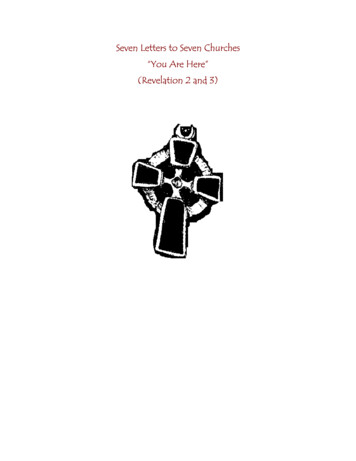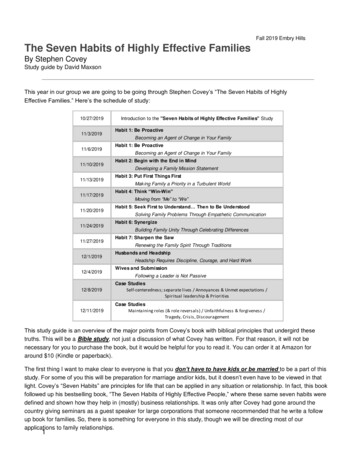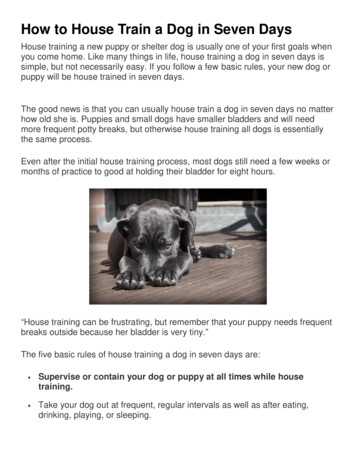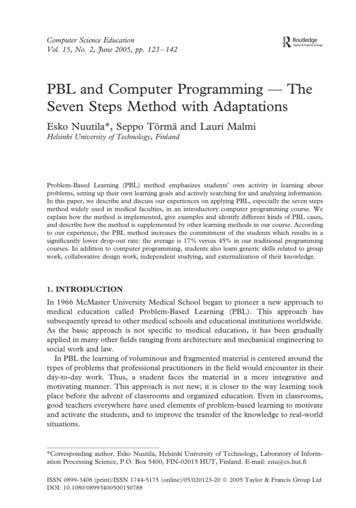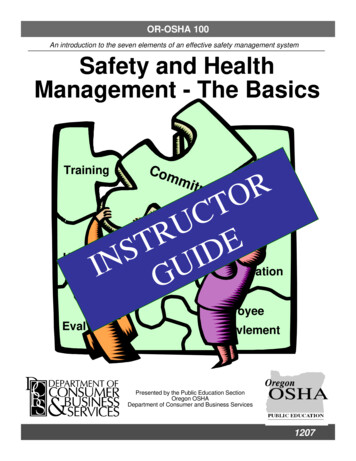
Transcription
OR-OSHA 100An introduction to the seven elements of an effective safety management systemSafety and HealthManagement - The cidationationoyeeEvalvlementPresented by the Public Education SectionOregon OSHADepartment of Consumer and Business Services1207
OR-OSHA Mission StatementTo advance and improve workplace safety and health for all workers in Oregon.Consultative Services Offers no-cost on-site safety and health assistance to help Oregon employers recognize and correct safety and healthproblems in their workplaces. Provides consultations in the areas of safety, industrial hygiene, ergonomics, occupational safety and healthprograms, new-business assistance, the Safety and Health Achievement Recognition Program (SHARP), and theVoluntary Protection Program (VPP).Enforcement Offers pre-job conferences for mobile employers in industries such as logging and construction. Provides abatement assistance to employers who have received citations and provides compliance and technicalassistance by phone. Inspects places of employment for occupational safety and health rule violations and investigates workplace safetyand health complaints and accidents.Appeals, Informal Conferences Provides the opportunity for employers to hold informal meetings with OR-OSHA on workplace safety and healthconcerns. Discusses OR-OSHA’s requirements and clarifies workplace safety or health violations. Discusses abatement dates and negotiates settlement agreements to resolve disputed citations.Standards & Technical Resources Develops, interprets, and provides technical advice on safety and health standards. Provides copies of all OR-OSHA occupational safety and health standards. Publishes booklets, pamphlets, and other materials to assist in the implementation of safety and health standards andprograms. Operates a Resource Center containing books, topical files, technical periodicals, a video and film lending library,and more than 200 databases.Public Education & Conferences Conducts conferences, seminars, workshops, and rule forums. Presents many workshops that introduce managers, supervisors, safety committee members, and others tooccupational safety and health requirements, technical programs, and safety and health management concepts.Additional Public Education Services Safety for Small Business workshops Interactive Internet courses Professional Development Certificates On-site training requests Access workshop materials Spanish training aids Training and Education Grants Continuing Education Units/Credit HoursFor more information on Public Education services,please call (888) 292-5247 Option 2Portland Field OfficeSalem Field OfficeEugene Field OfficeMedford Field OfficeBend Field OfficePendleton Field Office(503) 229-5910(503) 378-3274(541) 686-7562(541) 776-6030(541) 388-6066(541) 276-9175Go online to check out ourProfessional Development Certificate Program!Salem Central Office: (800) 922-2689 or(503) 378-3272Web Site: www.orosha.org
This material is for training use onlyWelcome!Understanding the big picture is critical to successfully managing a company’s safetyand health management system. Peter Drucker, a well-known management consultantsaid it this way, "The first duty of business is to survive and the guiding principle ofbusiness economics is not the maximization of profit, but the avoidance of loss."The primary emphasis of the workshop is to introduce you to the seven elements withinthe Oregon OSHA’s model for managing safety and health in the workplace. We’ll takea look at the design factors of each element and the processes that help to ensureeffective performance of the safety and health management system.To get the most out of this course, it’s important that everyone freely share theirknowledge and experience with the class, so please don’t hesitate.Goals1. Gain a greater understanding of safety management systems.2. Be familiar with Oregon OSHA’s seven core elements of a safetymanagement system.3. Be able to discuss the key processes within each of the seven core elements.Form GroupsIntroductionsElect a group leaderSelect a spokespersonRecordersWelcome everyone, introduce yourself and cover the goals for the course. If you have alarge class, you may want attendees to introduce themselves to each other at their tables.Form Groups. Encourage everyone to take notes.Please Note: This material, or any other material used to inform employers of compliance requirements of Oregon OSHA standardsthrough simplification of the regulations should not be considered a substitute for any provisions of the Oregon Safe Employment Act or forany standards issued by Oregon OSHA. The information in workbook is intended for classroom use only.OR-OSHA 100 Safety and Health Management - The Basics1
This material is for training use onlyWhat’s inside?The OR-OSHA Safety & Health Management SystemSeven Critical Components and Characteristics1.Management Commitment - Management of your company shows, in wordand actions, their commitment to your safety and health program.2.Accountability - Responsibilities and authority are assigned. All employees(including management) are held accountable for their responsibilities.3.Employee Involvement - Employees are encouraged to, and activelyparticipate in, the development and implementation of your safety and healthprogram.4.Hazard ID and Control - Your company has a system for regularly scheduledself-inspections to identify hazards and to correct and control them.5.Incident/Accident Analysis - There is a procedure at your company forinvestigating and reviewing all workplace near miss incidents, accidents, injuriesand illnesses.6.Training - There is a comprehensive program of safety and health training for allemployees (including management)7.Program Evaluation - The company has a system for evaluating the overallsafety and health program and does so on a regular basisBriefly state that you’ll discuss each of the seven OR-OSHA model elements. Don’t gointo detail at this time.OR-OSHA 100 Safety and Health Management - The Basics2
This material is for training use onlyThe basics: What’s a safety and healthmanagement system?What is the difference between a “program” and a “system”?A program is independentPPA system is interdependentPPPPPBriefly coverthe differencebetween aseries ofprograms andthe interactivenature of asystem.All systems have structure, inputs, processes and outputsThis is a simple structure. In smaller organizations, oneperson may wear one than one of these hats.StructureSafety Manager - The primary consultant on OR-OSHA mandated programs. Mayhave overall responsibility for safety management.The SM is the subject matter expert in OSHA regulations. Emphasize reporting to theproduction/operationsmanager, not human resources.Safety Engineer - Consults on the use of engineering controls to eliminate or reducehazards in the workplace.TheSE is usually a maintenance person. They needtraining in machine guarding, otherengineeringtype training.Human Resources Coordinator - Consults on human resource programs that impactthe safety and health of employees.HRprograms include EAP, DFW, Workplace Violence,Early Return to Work, Accountability,Incentive/Recognition, and of course claims management. Not the hub of the safety wheel.Safety Committee - Identifies, analyzes, and evaluates safety and health programs.SCmembers are the eyes and ears. An internal problem-solvingteam. Helps, but does not“do”safety. That’s the line organization’s job.OR-OSHA 100 Safety and Health Management - The Basics3
This material is for training use onlyThe Safety Management SystemA system may be thought of as an orderly arrangement of interdependent activities andrelated procedures which implement and facilitate the performance of a major activitywithin an organization. (American Society of Safety Engineers, Dictionary of Terms)All systems have structure, inputs, processes and outputsReview the inputs, processes, and output components of the safety management system. .InputsInputs -- litiesFacilitiesEquipmentEquipmentWe know Syssie the cow as structure, butwhat are her inputs, processes, outputs?Air, food, water, careInputsProcesses Stomachs,etc.OutputsMilk, waste, meMoneyMoneyTalk about how the safety management system is dynamic, just like Syssie.ProcessesProcesses –– SystemSystem mmitmentCommitment -- leading,leading, following,following, managing,managing, planning,planning, ,disciplineAccountability – role, responsibility, disciplineInvolvementInvolvement -- safetysafety committees,committees, suggestions,suggestions, n - inspections, audits, observation, surveys,surveys, interviewsinterviewsAnalysisAnalysis –– incidents,incidents, accidents,accidents, tasks,tasks, programs,programs, systemsystemControlsControls -- engineering,engineering, management,management, PPE,PPE, interiminterim measures,measures, maintenancemaintenanceEducationEducation -- orientation,orientation, instruction,instruction, training,training, personalpersonal experienceexperienceEvaluationEvaluation -- judgingjudging effectivenesseffectiveness ofof conditions,conditions, behaviors,behaviors, systems,systems, mplementationImprovement - change management, design, implementationBehaviors are the most direct effect of the safety management system. Next areconditions. These are leading indicators. Accident stats are trailing indicators.OutputsOutputs -- PerformancePerformanceFeedbackWhere do we look to evaluate how well thesafety management system is working?OutputsSafe/UnsafeSafe/Unsafe conditions,conditions, behaviorsbehaviorsMany/FewMany/Few incidentsincidents andand accidentsaccidentsHigh/LowaccidentcostsHigh/Low accident costsHigh/LowHigh/Low productivity,productivity, morale,morale, trusttrustWhat are the most immediate and observable outputs of a safetymanagement system?behaviorsOR-OSHA 100 Safety and Health Management - The Basics4
This material is for training use onlyProactive Vs. Reactive Approach to Safety & Health ManagementThey careabout me!Proactive ProgramsWhat's a proactive approach to safety?They don’tcare.Reactive ProgramsThis approach emphasizes doing everythingmanagement can to anticipate and preventaccidents.What's a reactive approach to safety?This approach emphasizes doing everythingmanagement must do to limit losses after anaccident occurs.Proactive Approach - Goal: Prevent future injuriesWhich safety programs and activities are emphasized?All OSHA programs are proactive.Incentives/recognition programs if they reward proactive behaviors.Appropriate discipline before someone gets hurtReactive Approach - Goal: Reduce injury costsWhich safety programs and activities are emphasized?Accident investigation, especially when it merely places blame.Early return to work, light dutyIncentive/recognition programs that reward for not having accidentsDiscipline for getting hurt"In organizations, clients for the services provided by staff people are called linemanagers. Line managers have to labor under the advice of staff groups, whetherthey like it or not. But any staff function, by definition, has no direct authority overanything but its own time, its own internal staff, and the nature of the service itoffers." Peter Block, Flawless ConsultingOR-OSHA 100 Safety and Health Management - The Basics5
This material is for training use onlyForFor moremore onon thisthis topictopic taketake CourseCourse 110,110, SafetySafety Leadership,Leadership, andandCourse112,SafetyandtheSupervisorCourse 112, Safety and the SupervisorELEMENT 1. Management CommitmentDiscuss the meaning of concepts within the ruleORS 654.010 Employers to furnish safe place of employment. Every employer shall furnish employment and a place of employment which are safe and healthful for employeestherein, and shall furnish and use such devices and safeguards, and adopt and use such practices, means, methods, operations and processes as are reasonablynecessary to render such employment and place of employment safe and healthful, and do every other thing reasonably necessary to protect the life, safety and health of such employees.It takes a little “TMC”Discuss the concept of commitmentTop Management Commitment is defined by how much Time, Money, and Concern the employer givesto safety. The degree to which managers demonstrate TMC indicates their understanding of the benefitsderived from an effective safety management system.What motivates management to make a commitment to safety?Employers are motivated to make a commitmentto safety to fulfill social, fiscal, and legalobligations. The obligation considered mostimportant influences the level of managementcommitment.To fulfill the social obligation We must save lives Do whatever it takesThis is the most effective strategy!To fulfill the fiscal obligation We must save money Do what we have toDiscuss each of these primarymotivating imperatives. Theseimperatives are actually a continuum.This is a better strategyTo fulfill the legal obligation We must stay out of trouble Do only what we have toHow can you tell which obligation isdriving decisions about safety?This is the least effective strategyManagement won’t make changes unless they are required by OSHA, save money, and/orsave lives, depending on what is primarily motivates the employer. To get to know what’sdriving the system, just try to change it.OR-OSHA 100 Safety and Health Management - The Basics6
This material is for training use onlyCommitment will shape a tough-caring safety cultureThe blue-collar definition of culture is, "the way things are around here." An effectivesafety culture includes a balanced use of positive and negative reinforcement.Positive Reinforcement. When effective, positive reinforcement increases requiredand voluntary behaviors.Discuss the meaning of concepts of positive reinforcement. Examples: Pay, benefits, recognition, rewardEmployees perform to receive promised positive consequencesEmployees may perform far beyond minimum standards to be rewardedBuilds trust between labor and managementLeads to higher levels of excellenceWhat do you hear from employees?9 “If I report a hazard, I know my supervisor will thank me.”9 “If I make some good suggestions, I'll have a better chance for that pay raise.”Negative Reinforcement When effective, negative reinforcement increases requiredbehaviors only. Discuss the meaning of concepts of negative reinforcement. Examples: fines, transfers, discipline, punishment, terminationEmployees perform to avoid promised negative consequences - fear basedEmployees perform to minimum standard - just enough to stay out of troubleBuilds fear of managementLeads to higher levels of compliance onlyWhat do you hear from employees?9 “If I wear that eye protection, my boss won't write me up.”9 “If I don't use fall protection, I'll get fired.”Extinction - Desired behaviors are "extinguished" when we do not acknowledgeemployees. Results in no expectation of positive consequences Employee is ignored - no positive relationship with management is established Initially, the employee will work harder in the hope of receiving a positive consequence, thengives up because they never get recognizedThis is the result of being What do you hear from employees?ignored. Unfortunately, it’s the9 “It doesn’t matter how hard I work around here.”most common management9 “If management doesn't care why should I?”response to good work in mostworkplaces.OR-OSHA 100 Safety and Health Management - The Basics7
This material is for training use onlyWhat do accidents cost your company?Unseen costscan sink theship!Direct CostsInsured“Just the tip of the iceberg”Average Cost to close a claim inOregon 14,499Discuss and giveexamples of direct andindirect costs. The figuresgiven are for 2005.1. Workers’ compensation premiums2. Miscellaneous medical expensesIndirect CostsHidden - Uninsured - Out of pocketAverage indirect costs in Oregon 60,000A few examples:1.2.3.4.5.6.7.8.9.Cost of wages paid for time lost by other non-injured workersNet cost to repair, replace, or straighten up material or damaged equipmentExtra cost due to overtime workCost of wages paid for supervisor activities related to employee injuriesWage cost due to decreased output of injured workers after returning to workCost-of-learning period of new workerUninsured medical costsCost of time to investigate accidents, process claimsMiscellaneous unusual costs. (over 100 other items)Ref: Grimaldi and Simons, Safety Management, ASSE Pub.The more serious theinjury, the lower the ratiobetween indirect and directcosts.OR-OSHA 100 Safety and Health Management - The Basicsinrryy ccoossttss injuinjulaintloatteoAAvveerraagge t on 4433,0,00000gneorgOerOStudies show that the ratio of indirect coststo direct costs varies widely, from a high of20:1 to a low of 1:1. OSHA's approach isshown here and says that the lower thedirect costs of an accident, the higher theratio of indirect to direct costs.8
This material is for training use onlyWorkers' Compensation Made SimpleIf you’re not familiar with how workers’ compensation works, studyor get help so you can talk about the concepts on this page.How are rates determined?Manual Rating - Also called the “Pure Premium Rate,” this rate is applied to all industries of thesame type or standard industrial classification (SIC). Expressed as:Dollars per 100 dollars of payrollExample: 3.15 per 100 dollars of payroll.Experience Rating - used to vary the company’s own rates, depending on its experience bycomparing actual losses with expected losses.3.75Manual .101.00.90.80.70.601.75MOD RateThe manualrate is the samefor allcompanies in agiven SIC.The worse youraccident record,the higher theMOD rate.1.50XYZ Contractors MOD Rate in 2003 1.3Classification DescriptionConcrete - Floor/DrivewayCarpentry - Multiple Family Dwel.Code52215651If the company has a profit margin of5%, additional business volume toreplace 78,500 would be 1, 570,000!Payroll 500,000 500,000Base Rate/Premium 1.26/ 63,000 3.97/ 198,500 261,500Adjusted Rate/Premium 1.64/ 82,000 5.16/ 258,000 340,000Adjusted Premium 261,500 78,500 340,000Review these examples. How WC is lowered.XYZ Contractors MOD Rate in 2004 .7Classification DescriptionConcrete - Floor/DrivewayCarpentry - Multiple Family Dwel.Wow! If you reduce your MOD Ratefrom 1.3 to .7, total savings will be 157,000. That’s 3.14 million inbusiness volume saved!Code52215651Payroll 500,000 500,000Base Rate/Premium 1.26/ 63,000 3.97/ 198,500 261,500Adjusted Rate/Premium .88/ 44,000 2.78/ 139,000 183,000Adjusted Premium 261,500 - 78,500 183,000OR-OSHA 100 Safety and Health Management - The Basics9
This material is for training use onlyTotal Claims: 22,5692003 Average Cost For DisablingClaims By Event or Exposure Partial ListAverage Cost: 13,107Event or ExposureLeading to Injury (Partial list)CLAIMSCLOSEDAVERAGECOST( 4,2491. Lifting objectsThe top 10 total2. Bodily reaction, other68% of all closed3. Repetitive motiondisabling claims.4. Fall to floor, walkwayErgonomicsinjuries total 46%5. Overexertion, all otherof all closed6. Non-classifiabledisabling claims!7. Pulling, pushing objects8. Caught in equipment or objects9. Holding, carrying, wielding objects10. Struck by falling 23.24.25.26.27.28.29.30.31.32.33.34.35.15, 362Struck against stationary object598Loss of balance549Highway accidents, collisions, other484Emphasize the top 10. Six of thetop 10 areStruck by, other475Fall to lower level, all otherergonomics-related injuries.369Fall from ladder367Fall from non-moving vehicle323Fall down stair or step283Assault or Violent Act by person249Struck against moving object161Struck by Vehicle157Exposure to noise146Jump to lower level142Fall from floor, dock, ground level119Fall to same level, other95Fall from roof67Vibration66Fall from scaffold61Highway noncollision accident, other41Explosion23Contact with electrical current22Fall from stacked material21Bodily reaction, exertion, other13Exposure to traumatic event13Caught in collapsing 8620,495You may request a complete list from the Research and Analysis Section, Information Management Division, Departmentof Consumer and Business Services. http://www.cbs.state.or.us/imd/orosha.htmlOR-OSHA 100 Safety and Health Management - The Basics10
This material is for training use onlyForFor moremore onon thisthis topictopic taketake CourseCourse119,119, SafetySafety AccountabilityAccountabilityELEMENT 2. AccountabilityIt’s important that the employer fulfill legal obligations to the law and everyemployee. The "condition" of effective workplace safety accountability will exist if(1) appropriate behaviors are (2) objectively evaluated and (3) result in eEffectiveAccountability Behavior Evaluation ConsequencesDiscuss accountability as a “condition” in the safety management system.Accountability exists when the above occurs.ORSORS 654.022654.022 DutyDuty toto complycomply withwith safetysafety andand healthhealth orders,orders, decisionsdecisions andand rules.rules. EveryEveryemployer,employer, owner,owner, employeeemployee andand otherother personperson shallshall obeyobey andand complycomply withwith everyevery requirementrequirement ofof everyevery order,order, decision,decision, direction,direction, standard,standard, rulerule ororregulation regulation dodo everythingeverything necessarynecessary oror properproper inin orderorder toto securesecure compliancecompliance withwith andand observanceobservance ofof leorregulation.such order, decision, direction, standard, rule or regulation.Discuss the rules.OAROAR 437-001-0760437-001-0760 RulesRules forfor allall WorkplacesWorkplaces(1)(1) Employers’Employers’ Responsibilities.Responsibilities.(a)(a) TheThe employeremployer shallshall seesee thatthat workersworkers areare properlyproperly instructedinstructed andand supervisedsupervised inin thethe safesafeoperationoperation ofof anyany machinery,machinery, tools,tools, equipment,equipment, process,process, oror practicepractice whichwhich theythey areare authorizedauthorizedtouseorapply.to use or apply.(b)(b) TheThe employeremployer shallshall taketake allall reasonablereasonable meansmeans toto requirerequire employeesemployees to to According to the rules above, what is the employer required by to do?Comply, enforce, instruct, supervise,OR-OSHA 100 Safety and Health Management - The Basics11
This material is for training use onlyOAROAR 437,437, DivDiv 001,001, RuleRule 0765(6)(f)0765(6)(f) Accountability.Accountability. TheThe safetysafety committeecommittee shallshall evaluateevaluate ’s accountability system and make recommendations to implement supervisor and employeeaccountabilityaccountability forfor safetysafety andand health.health.Briefly review the rule and checklist if you have time.An effective accountability system includes the following six key elements. You can usea checklist like the one below to evaluate your accountability system. Consider using arating system such as 0 Does not exist, 1 Inadequate, 3 Adequate, 5 Excellent1. Formal standards and expectations. Before employees can be held accountable,management must design and communicate employee accountabilities.— Do clear safety policies, plans, processes, procedures, practices exist?— Are safety standards written in the primary language(s) of all employees?— Are safety policies and rules clearly communicated to all employees?— Are reasons discussed for the importance of following safety rules and policies?Why is it so important to write formal plans, policies, procedures andrules?Written plans clarify expectations responsibilities and lower stress. Everyoneunderstands what to do.Why is it important to discuss why policies, procedures and rules areneeded?According to research, the number one reason employees don’t do what they’resuppose to do in the workplace is because they don’t know “why” they need to do it.If people are taking shortcuts in areas such as safety and quality, the naturally occurring positiveconsequences associated with doing the job with less effort will cause the undesirable behaviors tocontinue. Aubrey, C. Daniels, Bringing Out the Best in People, p. 29OR-OSHA 100 Safety and Health Management - The Basics12
This material is for training use only2. Resources to meet/exceed expectations. Before management can holdemployees accountable, they must first fulfill their obligation to provide employeeswith the tools to perform safely.Physical Resources— Are tools, equipment, machinery and materials adequate in ensuring a safe workplace?— Are workstations designed to be ergonomically appropriate for the assigned worker?— Is adequate Personal Protective Equipment provided to employees?— Are chemical, noise, atmospheric and other environmental safety hazards controlled?Social Support— Is adequate initial safety orientation training being provided?— Is adequate safety training on specific safety procedures being provided?— Is management providing adequate safety leadership through example?— Does the employee have the ability to complete work without undue physical or psychologicalstress?— Does the workload or schedule produce excessive fatigue?— Is an Employee Assistance Program (EAP) available?— Do employees suffer negative consequences from using safe procedures and practices?— Do positive working relationships exist between employees and supervisors?If management fails to provide adequate resources and support, how doesthat affect the ability to hold employees accountable?If management does not fulfill the obligation to provide resources, they are notjustified in holding employees accountable. Employees do not have the ability toachieve standards of performance. They are “trapped”. Failure is predictable.OR-OSHA 100 Safety and Health Management - The Basics13
This material is for training use only3. A process to evaluate behaviors. It’s important that behaviors are measured andevaluated so that discipline is based on facts, not feelings.— Is a process to observe behaviors and provide feedback carried out effectively?— Are compliance behaviors evaluated instead of the employee's injury record?— Are the results of observations being tracked to improve the safety management system?— Do formal appraisals/reviews index safety performance?Why is this statement true?"When an employee is disciplined, that fact that there was an accident is irrelevant."Employees should be disciplined only for substandard behavior and the safetymanagement system has not failed the employee. Punishing an employee for gettinghurt is never justified.4. Effective consequences. Without effective consequences, improvement ofbehaviors and performance will not occur.— Is discipline for noncompliance expected?— Does discipline occur soon after justification is established?— Do employees know exactly why they are being disciplined?— Are the motives for disciplining perceived as a sincere attempt to help, not hurt?— Do disciplinary procedures change behavior/performance in the desired direction?— Is "progressive" discipline administered for repeated violations?Why does discipline need to be "progressive" to be effective?What is considered a significant consequence varies among employees. Effectivediscipline will change behavior in the desired direction. Discipline that changes thebehavior of one employee may not change the behavior of another.OR-OSHA 100 Safety and Health Management - The Basics14
This material is for training use only5. Appropriate application of Consequences. Appropriate consequences ensurediscipline is justified and perceived as fair.— Does management first make sure that their obligations to employees have been fulfilledbefore disciplining? (clear expectations, resources, training, enforcement, leadership)— Does discipline occur as a result of failure to comply with safety policies and rules (behaviors)rather than “having an accident” (results)?— Are employees automatically disqualified from safety recognition/rewards if they have anaccident?— Is discipline consistently applied throughout the organization - top to bottom and acrossfunctions?— Is the purpose of discipline to improve performance rather than merely to punish?— Is recognition occurring more often than discipline?— Is discipline appropriate to the severity of the infraction?R E STLFor discipline to be justified, those in control should fulfill theirobligations to the employee first. To make sure obligations arefulfilled, conduct a self-evaluation.What questions should the supervisor or manager askbefore administering discipline?1. Have I ensured the employee is adequately T ?Training2. Have I made sure the employee is provided adequate R ?ResourcesEnforce3. Have I effectively Esafety rules?Supervision4. Have I provided adequate S ?Leadership5. Have I personally demonstrated safety L ?OR-OSHA 100 Safety and H
offers." Peter Block, Flawless Consulting What's a proactive approach to safety? This approach emphasizes doing everything management can to anticipate and prevent accidents. What's a reactive approach to safety? This approach emphasizes doing everything man
